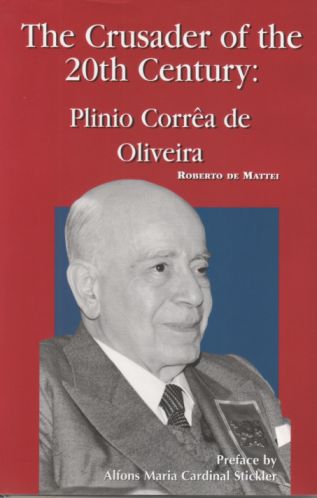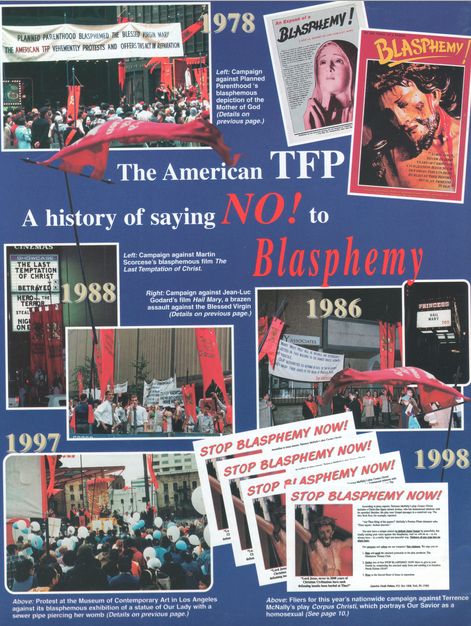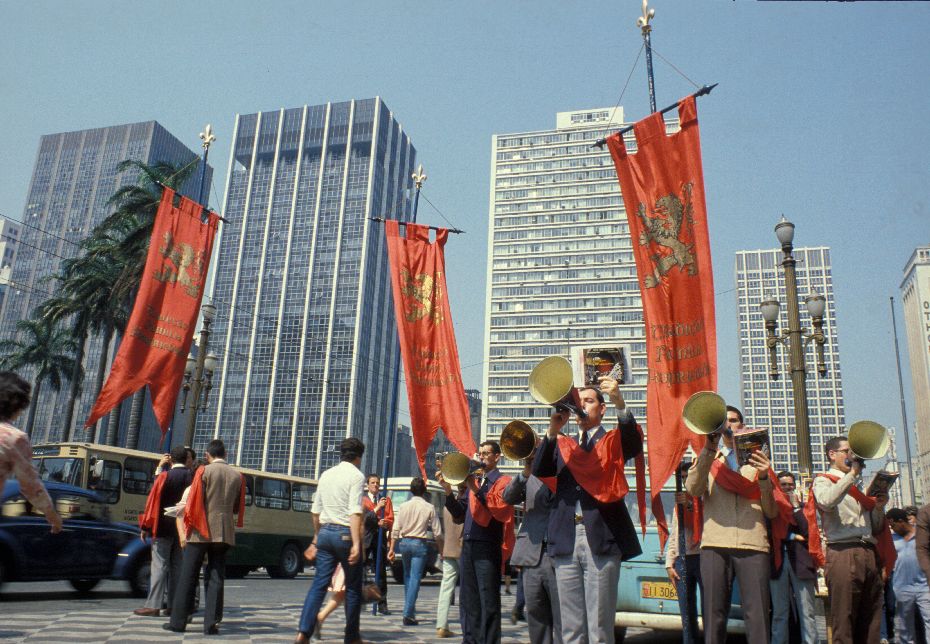|
Chapter V
14. A specific vocation: the
"consecratio mundi"
|
|
|
Throughout its history, the TFP, presided over by Plinio Corrêa de Oliveira, defended itself from the numerous violent attacks launched against it. These rebuttals provided an excellent occasion for defining its physiognomy in an increasingly precise manner. What then is the TFP? It is foremost a school of thought that draws from a wide intellectual patrimony, rich in both speculative and operational principles. “What is necessary in the TFP’s school of thought? First of all, a total and enthusiastic adhesion to the doctrine of the Holy Roman Catholic and Apostolic Church as expressed in the teachings of the Roman Pontiffs and the ecclesiastical Magisterium in general (attributing to each document, according to its nature, the fullest deference decreed by Canon Law). Then, an adhesion to a whole series of theoretical or theoretico-practical principles that were deduced, with scrupulous logical rigour, from Catholic doctrine or the analysis of reality - whether present or historical - according to the methodology and criteria carefully elaborated in the TFP, and whose foundations are to be mostly found in the aforementioned treatise Revolution and Counter-Revolution. Finally, an adhesion to a series of operative principles developed through an attentive analysis of their practical application over a period of decades of acting in common. Such principles also have their foundations outlined in Revolution and Counter-Revolution (Part II, Chap. V to XI). The ensemble of these principles constitute the fundamental patrimony of the TFP’s school of thought.”129 The term, “school of thought” does not however fully cover the vocation of the TFP, which even if born as a simple civic association, in over thirty years has been characterized, ever more profoundly, as a family of souls not without similarities to a religious family. The relation established over the years between Dr Plimo and the members of the TFP is in fact similar to that existing between the founder of a religious institution and his disciples. What is the current position of this family of souls with respect to the ecclesiastical authorities? “It is that of the full liberty that the Church itself gives to simple germinating nuclei or to Catholic societies being born.”130 Vatican Council II in fact declared the freedom of association within the Church, affirming that “the laity have the right to establish and direct associations”.131 “There is no reason” comments Father Anastasio Gutierrez “for denying this freedom aimed at Christian perfection and lay apostolate: indeed these goals are explicitly admitted for the freedom of association.”132 For Canon Law the TFP is a private association of lay persons subjected in rebus fidei et morum (in matters of Faith and Morals) to the vigilance that the Church exercises over all its faithful, taken individually or associated between each other. The juridical nature of these civic associations does not change because religious practices are exercised within them and because their members adopt forms of life similar to those of the consecrated life.133 “Given this situation, the TFP and its family of souls have a special characteristic. As an association, the TFP is an exclusively civic society. Its members, taken individually, are free to practice what they want as Catholics. Thus the TFP appears as a place where these Catholics, considered individually, live their religion according to the common practises that the Church has always proposed to its faithful.”134 It should be noted that what distinguishes lay associations from ecclesiastical associations is not their goal, which in both cases is religious but the fact that they are or are not established at ecclesiastical level' The aim of the TFP, expressed by Article 1 of its statutes, consists in working for the restoration of the fundamental principles of natural and Christian order. This aim is no different from the mission of “to restore all things in Christ”135 and “consecrate the world”136 so often referred to by the Pontiffs of this century and which Vatican Council II, in the Decree Apostolicam Actuositatem, defines “instaurationem Ordinis temporalis” (the restoration of temporal order).137 John Paul II himself, quoting the Council138 affirms that “it is the special task of the lay faithful to bring the truth of the Gospel to influence the reality of social, economic, political and cultural life. They have the specific task of the sanctification of the world from within by undertaking secular activity”.139 With these words he simply confirms what was already said by Vatican Council II: “The lay person receives, through the grace of God, a specifically lay vocation which destines him to seek holiness and to exercise an apostolate which deals with temporal themes ordered according to God.”140 Plinio Corrêa de Oliveira, who since the Thirties has argued with progressivism for the improper role it attributed to the laity with respect to the clergy, was paradoxically accused of exaggerating, at the expense of the clergy, the role of the laity in the service of the Church. The reality is quite different. According to Catholic doctrine, spiritual and temporal order are distinct realities, but not separate ones, as is already implicit in the recommendation of Our Lord to render to Caesar what is Caesar’s and to God what is God’s.141 The liberal principle of the separation of the two spheres, however, penetrated, after the French Revolution, into Catholic circles. The result was that, while in some political sectors it was imagined that there would be a temporal restoration which would disregard grace and the supernatural, in other ecclesiastical sectors, on the contrary, the role of nature, reason and of man’s free co-operation with divine grace tended to be minimized. These were the two errors of naturalism and supernaturalism destined to explode after the pontificate of Pius XII. These ambiguities were translated into unilateral and arbitrary exaggerations of the role of the laity or, per diametrum, of the clergy in society. The Magisterium of the Church, to which Plinio Corrêa de Oliveira constantly conformed, indicates the path to a harmonious balance. The action of the laity does not derive from a natural tendency to action, but from the characteristics of Baptism and Confirmation, which impose the duty of apostolate,142 which is none other than the exercise of Christian charity that is the duty of all men.143 The laity form a holy nation, they are consecrated to God with Baptism and with Confirmation, they are called to honour God with the holiness of their lives and with their participation in the worship of the Church. They have a special mission to “consecrate” the temporal order to God. “Dignity, consecration, a mission that Sacred Scripture and Tradition summarize and indicate with one word: royal priesthood of the faithful.”144 Plinio Corrêa de Oliveira, on this point, always echoed the Church’s doctrine. “Our modern mentality” observes a contemporary Catholic writer “finds it difficult to understand how in the past the laity were able to play an important role in the spiritual field without the clergy taking offence.”145 He recalls the cases of St Benedict and St Francis of Assisi, who founded and directed their orders without ever reaching priesthood. Likewise, St Ignatius preached his Exercises and gathered his first followers much before becoming a priest. We could give other examples, such as that of the famous Baron de Renty,146 a lay gentleman and father of a family who spiritually directed some monasteries of nuns. The monks of the early centuries were mostly lay as were the military orders of Knights Hospitallers of the Middle Ages, as well as the teaching institutes founded after the seventeenth century. “According to the traditional doctrine of the Church” states John Paul II “consecrated life by its nature is neither lay nor clerical,147 and for this reason ‘lay consecration’, be it male or female, is a state in itself complete of profession of the evangelical counsels.148 Therefore, for the person and for the Church, it has its own special value, that is independent of the sacred ministry.”149 In this perspective, the TFP, next to the married members and followers, has many who have renounced marriage choosing a state of life which is neither priestly, nor religious. Perfect chastity, Pius XII teaches in the encyclical Sacra Virginitas, is not reserved only for the religious, it can also be advised for the simple laity, “men and women”.150 The invitation to perfect chastity is after all constantly recommended by the Church as a choice that achieves a state of life that is superior to marriage, finalized in a mission of works of charity, or teaching, or apostolate.151 John Paul II has also often stressed the importance of continence and chastity in Christian life. The Christian who is coherent with the Gospel “must insist on high ideals, even if they go against current opinion”. “Jesus Christ (...) said that the way of continence, of which he himself is a witness with his life, not only exists and is possible, but it is particularly valid and important for the Kingdom of Heaven. And this is how it should be, since Jesus Christ chose it for himself.”152 The specific vocation of the TFP, that of lay people who work for the “consecratio mundi”, may cause confusion because of its novelty and uniqueness within the Church. On the other hand, “St Anthony probably did not have many forerunners when he left for the desert”, writes Father Henry, stressing the fact that the Holy Spirit can raise up something that is “completely unprecedented in the Church”.153 In fact, according to the theologians, no merciful work exists for whose accomplishment a religious order cannot be established.154 This is why the Church contains in its maternal bosom a marvelous variety of orders, congregations and religious families, even secular ones, each of which, in responding to the various requirements of the times and souls, demonstrate the different aspects of radicality of the Gospel and of the life of the Church.155 All refer back to the charism of their founder.156 “Whether or not they are canonized” comments Father Olphé-Galliard “the founders are bearers of a charism that enables them to give rise to a spiritual family destined to carry forward the lymph of their holiness. The authenticity of the latter is recognized both by the fruitfulness of their foundation, and by the example of their personal experience. ”157 What his biographers said about St Pancomius and his disciples has been repeated about many founders: “After God, he was their Father”.158 “Imitation of the founder” as Father Olphé-Galliard notes again “has nothing to do with the cult of the personality generated in honour of certain modern ideologies.”159 It emanates from that principle of mediation according to which every paternity comes from God.160 It cannot be denied that Plinio Corrêa de Oliveira has the characteristics of a Founder. A Founder not because he wanted to impose this role upon himself, but because he is thus recognized by thousands of Catholics all over the world. A Founder in the broad sense, not so much of a specific order, but of a spiritual and intellectual school and of a style of life of open fight against the Revolution. "Novum militiae genus ortum nuper auditur in terris .... 161 “Now we hear that a new kind of knight has appeared on the earth....” The words of St Bernard can be well applied to the disciples of Plinio Corrêa de Oliveira, who thus summarizes the contemporary version of the chivalrous style of long ago: “In idealism zeal. In manners, courtesy. In action, dedication without limits. In the presence of the enemy, prudence. In the fight, pride and courage. And with courage, victory.”162
Notes: 129) P. CORRÊA de Oliveira, A Réplica da Autenticidade, pp. 132-3. 130) A. Sinke Guimarães, Servitudo ex caritate, p. 266. 131) Vatican Council II, Decree Apostolicam Actuositatem on the Apostolate of the laity of 18 November 1965, no. 19. 132) A. Gutierrez C.M.F., entry Istituti di perfezione cristiana, in DIP, vol. V, 1988, col. 85, cols. 75-106. 133) In the book Refutação da TFP a uma investida frustra, we read that: “the TFP may be considered as a confraternitas laicalis, that is, as an association of Catholics with religious objectives, which is not set up or controlled by the ecclesiastical authorities and whose members therefore direct it freely according to its by-laws” (vol. I, pp. 319-320). Cf. also Comissão de Estudos da TFP, A TFP: uma vocação. TFP e famílias, TFP e famílias na crise espiritual e temporal do século XX, São Paulo. Artpress, 1986, vol. I, pp. 271-2; A. Sinke Guimarães, Servitudo ex caritate, cit., pp. 157-160. “Thus - commented Dr Plinio - the TFP is perfectly well defined as a civic entity under civil law, and as a confraternitas laicalis under ecclesiastical law, at least until in-depth studies of the new Code of Canon Law indicate a more adequate terminology" (P. Corrêa de Oliveira, A réplica da autenticidade, p. 219). On the nature of the TFP as regards Canon Law cf. also G. A. Solimeo and L. S. Solimeo, Analyse par la TFP brésilienne d'une prise de position de la CNBB sur la ‘TFP et sa famille d'âmes'. 134) A. Sinke Guimarães, Servitudo ex caritate, pp. 159-60. 135) St. Pius X, Letter Notre Charge Apostolique. 136) Cf. Pius XII, Speech of 5 October 1957 for the World Congress of the Apostolate of me Laity, in DR. vol. XIX, pp. 459-60. 137) Cf. J. Collantes S.J., La fede della Chiesa cattolica, p. 320. 138) Cf. Vatican Council II, Constitution Lumen Gentium, no. 31. 139) John Paul II, Speech to United Slates bishops of 2 July 1993, L’Osservatore Romano, 4 July 1993. 140) Vatican Council II, Constitution Lumen Gentium, no. 316. 141) Luke 20:25; Mark 12:17; Matt. 22:21. 142) Pius XI, Letter Ex officiosis litteris of 10 November 1933 in IP, Il laicato, p. 532. 143) Pius XI, Letter Vos Argentinae Episcopos of 4 December 1930, in IP, Il laicato, p. 320. 144) P. G. Rambaldi S.J., “Sacerdozio gerarchico e sacerdozio non gerarchico", Civiltà Cattolica, vol. 102, 1951, no. II, pp. 354-5, pp. 345-57. 145) Daniel Raffard de Brienne, L’Action catholique, (Paris, Renaissance Catholique, 1991), p. 8. 146) On Baron Gaston de Renty (1611-49), a number of times superior of the Society of the Most Holy Sacrament and promoter of the Catholic renaissance in France in the seventeenth century, cf. the famous biography by Father Jean Baptiste Saint-Jure S.J., La vie de monsieur Renty, ou le modèle d'un parfait Chrétien, Paris, Le Petit, 1651, and recently Yves Chiron, Gaston de Renty. Une figure spirituelle du XVIII siècle, Montsûrs, Editions Résiac, 1985; Raymond Triboulet, Gaston de Renty. 1611-1649, Paris, Beauchesne, 1991; Id., entry in DSp, vol. XIII (1987), coll. 363-9. 147) Cf. Code of Canon Law, can. 588, §. I. 148) Cf. Vatican Council II, Decree on the renewal of religious life Perfectae caritatis, no. 10. 149) John Paul II, Apostolic Exhortation Vita Consacrata, of 25 March 1996, suppl. to L’Osservatore Romano, 26 March 1996. 150) Pius XII, Encyclical Sacra Virginitas of 25 March 1954, p. 163. 151) To preserve the virtue of chastity, the TFP recommends great vigilance. It especially warns its young people against going to beaches, mixed swimming pools, discos, places of dissipation, and promiscuity that put their purity at obvious risk. This vigilance, an expression of genuine Catholic spirit, is one of the points that irritates most the so-called “anti-cult movement”, ideologically dependant on Freudian pan-sexualism. 152) John Paul II, Audience of 31 March 1982, in Insegnamenti, vol. I, 1982. p. 1047. 152) A. M. Henry O.P., Obéissance commune et obéissance religieuse, suppl. to "La vie spirituelle”, 15-9-1953, b. 26, VI, 1953, p. 258. 154) Paul Philippe, Les fins de la vie religieuse selon saint Thomas d'Aquin, (Alenas, Fraternité de la Très-Sainte-Vierge Marie, 1962), p. 88. 155) Pius XII, in his Address to the I World Congress for the Apostolate of the Laity of 14 October 1951 (in DR, vol. XII, pp. 291-301), insists on this great liberty that the Church allows the faithful in choosing the road which best suits them. 156) The expression “charism of the founders” entered the official language of the Magisterium with the Evangelica Testificatio no. 11 (1971). It indicates the gifts of nature and grace bestowed on the founder of a spiritual family for achieving his mission. On “founders” cf. Juan Maria Lozano, C.M.F., El fundador y su familia religiosa. Inspiración y carisma, Madrid, Publicaciones Claretianas, 1970; Fabio Ciardi, I fondatori uomini dello spirito. Per una teologia del carisma del fondatore, Rome, Città Nuova, 1982; ID., In ascolto dello spirito Ermeneutica del carisma dei fondatori, Rome, Città Nuova, 1996; A. Sinke Guimarães, Servitudo ex Caritate, pp. 184-210; Elio Gambari S.M.M., J. M. Lozano C.M.F., Giancarlo Rocca S.S.P., entry Fondatore, in DIP, vol. IV (1977), coll. 96-101; Michel Olphé-Galliard S.J., entry Fondatore, ibid, coll. 102-08; G. Damizia, sub entry, in EC, vol. 5, 1950, pp. 1474-5; J. F. Gilmont, “Paternité et médiation du fondateur d'Ordre”, Revue d’Ascétique et de Mystique, vol. 40, 1964, p. 416, pp. 393-426; Francisco Juberias, C.M.F.. “La paternidad de los fundadores”, Vida Religiosa, vol. 32, 1972, pp. 317-27. 157) M. Olphé-Galliard S.J., entry Fondatore. col. 102. 158) Ibid, col. 103. 159) Ibid. 160) Eph 3:5. 161) St. Bernard of Clairvaux, De Laude novae militiae, in Franco Cardini, I poveri cavalieri del Cristo, (Rimini, Cerchio, 1994), p. 132. 162) P. Corrêa de Oliveira, “Estilo”, Folha de S. Paulo, 24 September 1969. |
|



